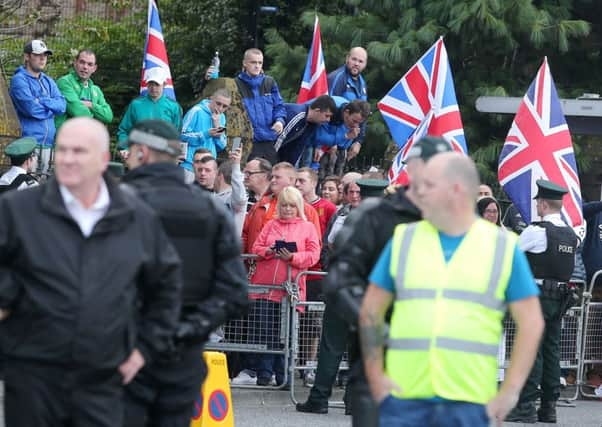Memory of Protestant role in 1798 rising still lies beneath surface


The multiplicity of events may suggest Northern Ireland, along with the Republic of Ireland, is now afflicted with ‘commemoration fever’– a 21st century variant of what was called at the turn of the 19th century ‘statuomania’ (an obsession with putting up statues).
Present obsession with public remembrance does not sufficiently take on board a dynamic that can be labelled “decommemorating”, with reference to how certain commemorative celebrations can provoke vehement opposition from those who would rather stamp out memories that they consider to be offensive.
Advertisement
Hide AdAdvertisement
Hide AdThe ambiguous legacy of the 1798 rebellion in counties Down and Antrim, as well as adjacent parts of Derry, is particularly instructive for uncovering deeper layers of memory and the strong emotions they can arouse.
It has been claimed that unionist Presbyterians completely erased the memory of the participation of their ancestors in the rebellion of 1798, when Ulster-Scot ‘Dissenters’ rallied in droves alongside Catholics, and some Anglicans, to the banner of the United Irishmen.
Yet this assumption of sweeping collective amnesia is misleading.
Writing in 1960, the historian Charles Dickson, a county Down Presbyterian who was a decorated officer in the Great War and later moved to Dublin, attested from “personal knowledge” that “there is many an Orangeman in the counties of Antrim and Down today whose proudest boast it is (in private) that his ancestor had a pike in his thatch in ’98”.
Advertisement
Hide AdAdvertisement
Hide AdSuch covert memories were retained for more than two centuries in conditions of “social forgetting”: behind a façade of professed oblivion, folk histories continued to recall local traditions of the 1798 insurrection (sometimes referred to by euphemistic nicknames, such as “The Turn-Out” or even “The Troubles”).
When these muted recollections emerged into the public sphere, their appropriation by nationalists antagonised unionists and could incur hostility.
Such was the case on May 1 1898, when a loyalist mob from around Ballynahinch prevented nationalist visitors from Belfast from laying wreaths at a recently-erected monument to the local heroine Betsy Gray (the only memorial dedicated to a United Irishwoman).
In the riot that ensued, the monument was smashed to pieces – yet the assailants kept fragments as cherished souvenirs.
Advertisement
Hide AdAdvertisement
Hide AdMany years later, an 82-year old man with a “very retentive memory” who had witnessed the destruction as a child, recalled how “they didn’t like those people claiming Betsy and they decided to prevent the ceremony from taking place”.
Other prominent examples coincided with the violence of the Troubles.
In January 1969, when the People’s Democracy civil rights march from Belfast to Derry (which culminated in the notorious incident at Burntollet Bridge) reached the village of Toome, they found that the monument to the local folk rebel hero Roddy McCorley (who had been adopted, somewhat ahistorically, as a nationalist figure) had been destroyed the previous night.
A couple of years later, in April 1971, the Celtic cross tombstone in Mallusk cemetery of Francis Joseph Bigger, the Protestant antiquarian who had dedicated his life to erecting memorials and commemorating the northern United Irishmen, was destroyed by explosives.
Advertisement
Hide AdAdvertisement
Hide AdIn a twist of irony, Ulster’s great commemorator had been decommemorated!
The literary critic Edna Longley astutely remarked, “commemorations are as selective as sympathies; they honour our dead, not your dead”.
Indeed, struggles over memory are often driven by conflicting urges of “commemorative possession” (when a party claims sole ownership of an event) and “commemorative envy” (when another party asserts the right to reclaim its heritage). This clash can result in silencing of non-compliant memories.
There is an unacknowledged history of how individuals and communities across north-east Ulster found ways to discreetly remember their United Irish forebears, even when such memories were discouraged.
Advertisement
Hide AdAdvertisement
Hide AdRecurring instances of decommemorating, most recently apparent in April 2014 with the defacement of a blue plaque in Mallusk graveyard honouring the ‘man of no property’ and 1798 rebel James (Jemmy) Hope, are an indication of continued aversion to public airing of controversial memories.
The paradox is that aggressive attempts to stamp out commemoration leave a strong impression and so actually ensure that inconvenient episodes will be remembered.
• Guy Beiner is professor of Modern History at Ben-Gurion University of the Negev, Israel. He was giving a public lecture on his new book, Forgetful Remembrance: Social Forgetting and Vernacular Historiography of a
Rebellion in Ulster (Oxford University Press) at the Ulster Museum on Sunday, November 18